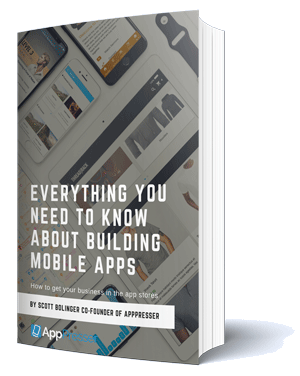7 MUSTS For Agencies Who Want to Develop Mobile Apps for Clients

I recently spoke with James, who owns a web development Agency in the UK. He has had some requests for mobile apps from his clients, and he is figuring out the best way to create those apps.
Here are a few things he mentioned to me:
- The client doesn’t have a huge budget or timeline, so a custom app is out of the question.
- The client is using WordPress along with some plugins like LearnDash and WooCommerce.
- The app should update when new content is posted or updated in WordPress.
- His team has development skills, but they don’t have experience with mobile apps.
In order to help James and other agencies like his, I thought about the best way for him to deliver a great mobile app to his client within his parameters. I came up with 7 “must-do” items for agencies, there’s probably more, but it’s a good start 😁
I hope this helps!
1. We are not re-building Uber. KISS!
I can’t tell you how many times customers have emailed us describing the features of the Uber app and asking how much it would cost.
Uber has over 250 employees and 25 BILLION dollars in funding. If you have to ask how much the app would cost, you can’t afford it.
If this is your client’s mindset, you need to talk them off the ledge. My advice is KISS – keep it simple stupid! Before you start the project, make sure you and your client are on the same page for the project. The way you can do that is by asking the right questions.
What are their goals? What features of the app are non-negotiable? What is the MVP (minimum viable product)? What features can wait for phase 2?
If you haven’t built apps before, I would highly advise convincing your client to start with a simple app, and then add complex features in later phases.
Find out what the most important feature of the app is, then create a simple version of that. For example, if your client has a WooCommerce store, get the products in the app and allow people to purchase. Save the super advanced barcode scanner and special features like loyalty rewards for phase 2.
Making sure you and your client are on the same page, and keeping things simple will increase your chances of success.
2. Underpromise, Overdeliver.
If you aren’t familiar with apps, don’t promise your client anything yet. Some people get overexcited about apps and want to build Twitter for this or Facebook for that. Lead your client towards simplicity, apps don’t need to be complex to be great.
Just like I mentioned above, keep things simple at first, you can always add more features later. Overpromising is a sure way to set yourself up for failure. Hopefully as the project goes on, you can add in some of the extra features your client really wanted. That helps you overdeliver instead of overpromise.
3. Build in a Cushion.
Apps are more complex than websites. You have to contend with native device features, testing, submitting to app stores, and more.
Make sure you build a cushion into your quote for unexpected hiccups along the way, like bugs found during the testing phase, or getting rejected by app store review.
If you are wondering how much to charge, read the interview with our friend Cody about estimating his first ever app project. There is a bit of a learning curve on your first app, so plan accordingly. Just like anything else, you will get better with each project.
4. Get Real. (With the Timeline)
Apps have some considerations you don’t have with websites. The timeline will completely depend on you, your client, and your project, but give yourself at least 6-8 weeks unless you have done this before.
Here are some items that take up your time:
- Mockups and implementation of the app design and features.
- Compile time for building the app for a device (and rebuilding after changes are made).
- Creating app store listings.
- App store review times.
- Possible app store rejection.
Mockup and implementation is probably similar to web projects. Keep in mind that compiling an app for native device testing takes several minutes. This doesn’t sound like much, but it adds up if you are making changes and rebuilding a lot.
Creating your app store listings isn’t that hard, but you are required to create screenshots and fill out app information, which just takes time. Using our free Figma and Photoshop app screenshot templates can help speed up this process.
Apple app store review can sometimes take 10 days. It’s a lot faster than it used to be, so the average is more like 3 days, but it’s best to plan for the worst.
If your app is rejected, you will need to make the changes requested by the reviewer, and then resubmit. This can take several days, depending on the rejection reason. Let’s take a closer look at app rejections.
5. Avoid App Store Review Surprises.
Getting rejected from the app store is not as serious as it sounds. Usually the reviewers ask you to make a few changes and resubmit your app, and most apps get accepted.
I’m mostly talking about the Apple App Store, since Google Play did not even have review until recently. However, Google Play has most of the same rules as Apple.
If your app abides by the Apple App Store Review Guidelines, in my experience you have a 99% chance of being accepted into the app store. That said, there are some capricious reviewers who will give you headaches. This is the exception, not the rule, but you should be prepared for it.
The guidelines are mostly common sense, but you should read them. Based on my experience here are some common rejection reasons you should look out for.
- In App Purchases – if you sell digital content or memberships, you must have an in app purchase available in the app. Read more here.
- Interactive features – Apple really wants to see interactive features. If you just add your blog posts to an app, it won’t pass review. Examples of interactivity would be login, purchases, forms, social interaction, saving data, etc.
- App description, privacy policy, and other information must be complete. If you leave anything out, they will reject the app and tell you to fix it.
For more detail, checkout this post for more reasons you could be rejected by Apple review. It’s not a big challenge to get past app store review if you follow their guidelines, but what do you do after you pass review?
6. Don’t Bail Early.
Your app is in the app stores, congratulations! Don’t close the book on this project yet, now you need to get people to use it.
Just like with a website, no one is going to show up unless you promote this app. Obviously your client will be writing a blog post and emailing their list about the app, but what else can you do?
- Create a landing page and link to it in the website menu.
- Add a smart banner, or at least some nice images with download links.
- Explore app store optimization, or ASO
- Test out some paid ads
- Submit the app for awards or showcases
There are lots of things you can do to help your client promote their app, use this as an opportunity to help them make this app successful.
7. Use the Right Tool for the Job.
Your main options when building apps for clients is to develop the app custom yourself, or use an app builder.
For this project, our friend James would be better off using an app builder. Of course I am biased because you are reading this on the AppPresser blog, but hear me out.
A custom app will fit every need of your client perfectly, like a custom tailored suit. But it also has higher up front costs, longer term maintenance needs, and requires special skills from your team. James doesn’t have the luxuries of a large client budget or employing an app developer, so why reinvent the wheel? AppPresser can already do everything he needs.
AppPresser is a great fit for this project because it’s affordable, it will save him tons of time, and help him make a profit and help his client. AppPresser code is well tested, and we release updates and new features regularly. If there is an issue, we can help James solve it quickly due to years of experience.
We also offer custom development if there is a special feature or tweak that your client really needs.
Get Started
With these 7 things in mind, your agency will be on its way to delivering well designed, performant apps that your clients will love.
If you are an agency or freelancer looking to build apps for your clients, AppPresser offers single app plans and reseller plans. To try it out before paying, start a free trial of AppPresser today.


Hey Scott, This is the ultimate post for building up clients for app development. Good points discussed!